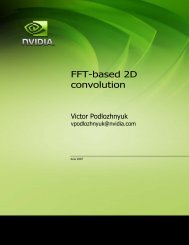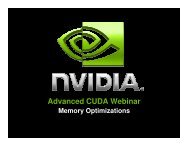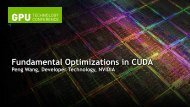Variance Shadow Mapping - Nvidia
Variance Shadow Mapping - Nvidia
Variance Shadow Mapping - Nvidia
You also want an ePaper? Increase the reach of your titles
YUMPU automatically turns print PDFs into web optimized ePapers that Google loves.
Motivation<br />
DX10-class hardware is perfect for VSM. Without fp32 filtering the algorithm must<br />
be done at fp16 precision which is not enough as the computation is numerically<br />
very unstable. In addition multisample anti-aliasing (MSAA) can be used to improve<br />
the quality of the shadow map by turning it on when rendering the shadow map.<br />
How Does It Work?<br />
<strong>Shadow</strong> maps work by first rendering depth from the point of view of the light to a<br />
texture. This texture now contains the closest fragments to the light. We can then<br />
query this shadow map when rendering our scene to determine if the fragment we’re<br />
shading is occluded by a fragment in the shadow map. Percentage-closer filtering<br />
(PCF) achieves soft shadows by filtering an arbitrary number of these queries.<br />
The problem with PCF is that there’s no good way to pre-filter the depth values, or<br />
arbitrarily filter the shadow map with something like anisotropic filtering or mipmapping.<br />
If you did, the depth value you arrive at is not a true occluder but the<br />
average of several possible occluders, which can produce artifacts.<br />
Summary of the Algorithm<br />
A detailed explanation of the algorithm can be found in the original <strong>Variance</strong><br />
<strong>Shadow</strong> Map paper by William Donnelly and Andrew Lauritzen at<br />
http://www.punkuser.net/vsm/ .<br />
In summary, the authors of VSM made the observation that what we’re actually<br />
trying to do with PCF is obtain a bound on the percentage of pixels over the PCF<br />
filter region whose depth is greater than a single depth value, the value of the pixel<br />
we’re shading. In other words we’re comparing a single value to a particular<br />
distribution of values (the region we’re sampling), and we want to know what<br />
percentage of those values are greater than the single value. We don’t care about<br />
individual samples, just the percentage of the distribution. To that end Chebyshev's<br />
inequality gives us this bound given the average (or expected value and<br />
variance of the distribution.<br />
January 2007 2
















